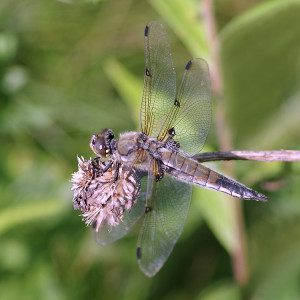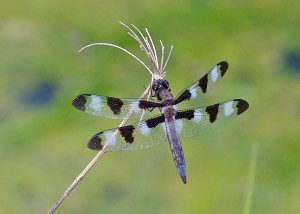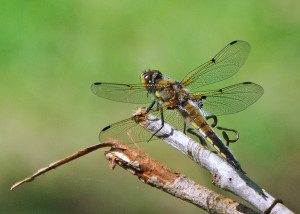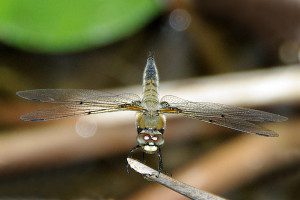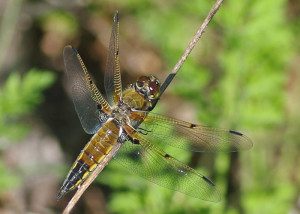Greetings, BugFans,
As The Bard once said – “What’s in a name?” Most sites that discuss the Four-spotted skimmer lead with its name, so the BugLady will, too. “Four-spotted? Why not Six-spotted? Or Eight (wait – that name is already taken, and so is Twelve, which is also pictured here – you only count the dark spots because females don’t have the white spots)? Or Ten? Who did the counting, anyway? Because, while the Four-spotted skimmer does indeed have four spots, it has more than that – two spots on each forewing and three on each hind wing. Bugguide.net weighs in with “Years ago many children referred to this as the “Six-spot”, and counted the basal spots as two crossing the thorax, instead of four separate spots. The same went for the then “Ten-spot”, which most recent books have switched to calling the “Twelve-spotted Skimmer”. The “Six-spot” name doesn’t seem to appear in any books, but was likely rationalized from comparison with the “Ten-spot” that was to be found in many books. Back then, Libellula forensis [the western Eight-spotted skimmer] didn’t seem to have an established published common name yet.” The spots are not visible in flight, and Four-spotted skimmers can be tireless flyers, so it may take a while before they land and you get to count them.
Four-spotted skimmers (Libellula quadrimaculata) appear on the scene fairly early in the dragonfly season – the BugLady usually sees them by the last week in May, and they can be found through August. The NJodes (New Jersey Odonates) (Odonatophiles?) website is among several that describes them as “chunky and dull-colored.” Chunky, yes; but while it is true that females are duller in color than males, and males fade some as they age, the young dragonflies glow.
They belong to the dragonfly family Libellulidae – the Skimmers – the so-called pond dragonflies – conspicuous and often colorful inhabitants of the air over (usually) still waters. Libellulids in the genus Libellula are often referred to as the King Skimmers – powerful fliers that, besides being large (or maybe because of it), dominate the pond. Their appearance throughout their flight period is changeable, because males develop a whitish/bluish deposit of waxy cells called “pruinescence,” especially on the abdomen, giving them a “hoary” appearance. Identifying the females and the juvenile males of various King Skimmers can be tricky (the BugLady has to review them each spring)https://www4.uwm.edu/fieldstation/naturalhistory/bugoftheweek/summer-dragonflies.cfm . Libellulid naiads – active, fast-growing, short-and-wide, hooked-and-spined – prefer shallower, warmer water than do the naiads of other dragonfly families.
The Four-spotted skimmer’s range is “circumpolar,” so internet searches turn up hits from Asia and from European countries (where it’s called the “Four-spotted chaser,” and where one of its predators is a large darner called the Emperor dragonfly). Its American range is listed as the northern half of North America.
These are dragonflies of marshy lakes, fens, acid bogs, plant-filled ponds, and very slow streams. Adults are found over fields and along woody edges and they may form swarms over open water; juveniles are often seen far from water. They like to perch on emergent vegetation but are also found near or on the ground. Four-spotted skimmers are so common throughout our north lands that in the 1990’s, the school children of Alaska proposed them as their State Insect, and the legislature subsequently agreed. Do you know your State Insect? For a list of Wisconsin’s state symbols, check our excellent DNR kids’ website, “EEK!” at http://dnr.wi.gov/eek/nature/state/.
Males patrol territories, both for feeding and mating purposes (two males will often “mix it up” in territorial spats), and they have favorite perches. According to Paulson in Dragonflies and Damselflies of the East, when populations are high, “some males adopt satellite behavior (subordinate to territorial male but [with a] chance of mating).” After mating (very) briefly in mid-air, the female lays eggs immediately. He does not retain a hold on her, but he does generally “hover guard” to protect her from both rival males and females. She dips her abdomen into the water as she flies above its surface, releasing as many as 3,000 white, gel-covered eggs that sink down and then stick to plants. The eggs soon turn brown; the BugLady found estimates of hatching times that ranged from five days to four weeks.
The naiads are also chunky, with dorsal and lateral spines near the rear of the abdomen. A British guide says that short hairs on the naiad’s exoskeleton trap debris, camouflaging it. The naiads are “sprawlers” that lurk on the muck, awaiting their unwary prey, and they are said (by the same British source http://online-field-guide.com/Libellulaquadrimaculata.htm) to “feign death to avoid being eaten.” They live underwater as naiads for two summers or longer (depending on water temperature). The British guide noted that studies done in Germany document that naiads emerged a month earlier in the 1990’s than in the 1980’s “as a response to climate warming.”
Naiads feed on aquatic invertebrates and the odd tiny fish. Adults hunt from perches, flying out and nabbing insects in the air, and they’ll take fellow dragonflies as large as Meadowhawks.
Across The Pond, they are intermittent migrators (every 10 to 15 years), sometimes in huge numbers, a phenomenon that may be driven by an infestation of parasitic trematode worms, which they may spread to birds that eat them (for this reason, diners in regions where dragonflies are on the menu should cook them well). This behavior is not seen in North America.
Kate Redmond, The BugLady
Bug of the Week archives:
http://www4.uwm.edu/

